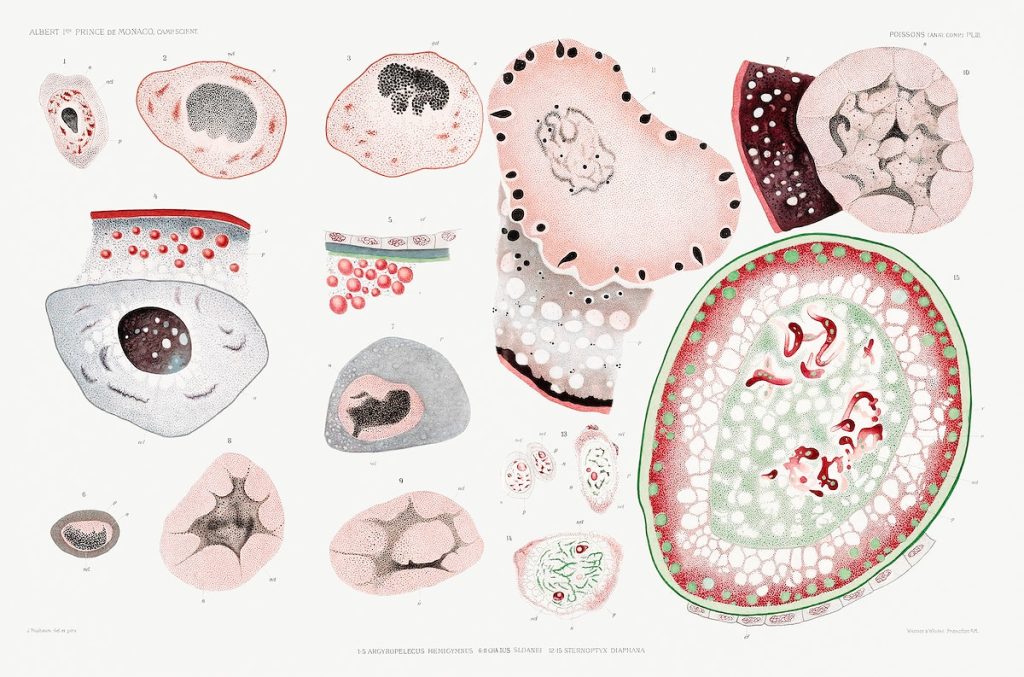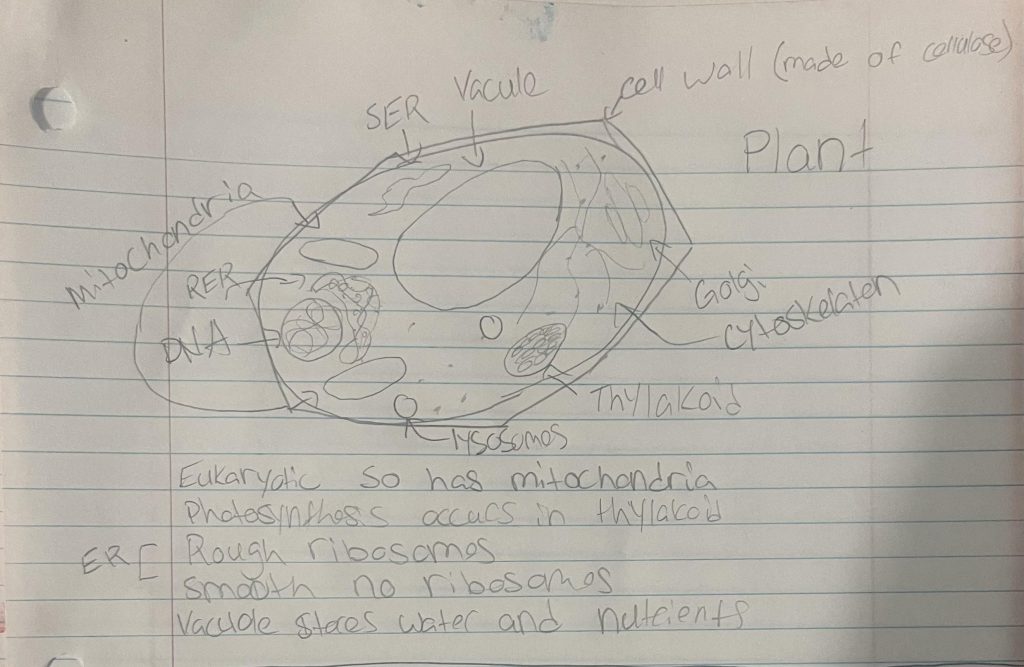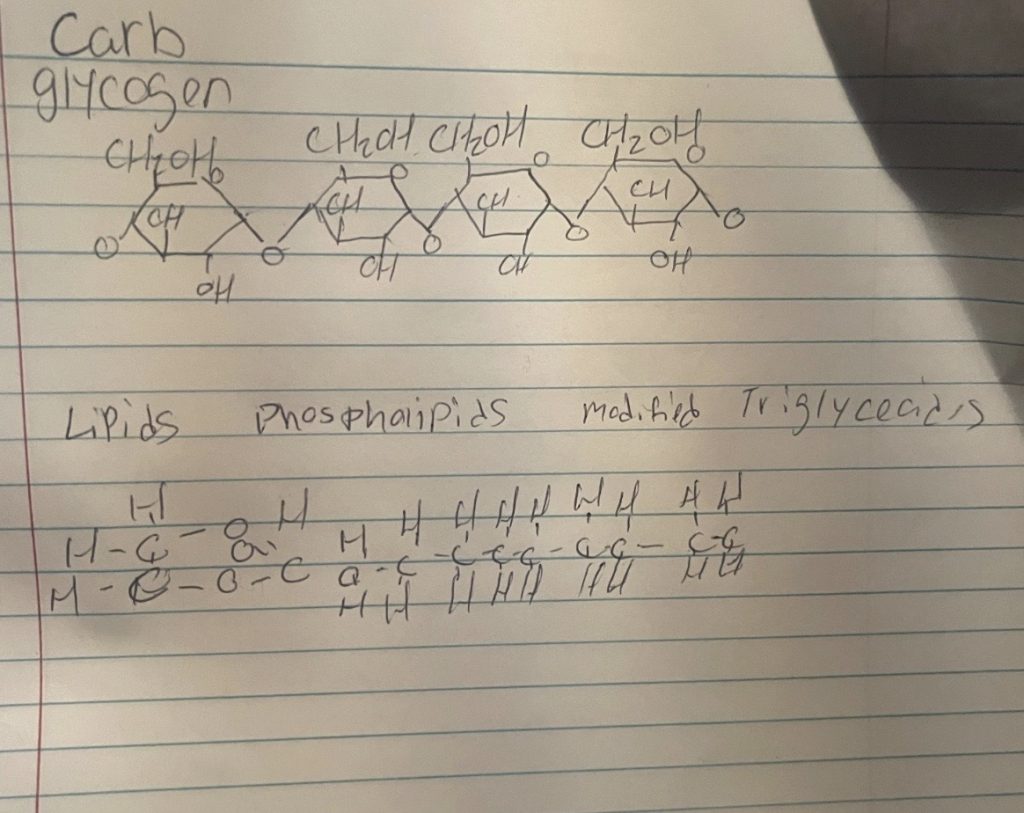
Cells make the world go around and are the reason I can even type this.
Plant Cell Body
This is a drawing of a plant cell below. This drawing highlights many important features of the many that help keep plant cells functioning.

Functions:
Mitochondria- The power house of the cell. This part of the cell is responsible for ATP Production Vacuole:
A membrane-bound organelle in cells, often used for storage and maintaining turgor pressure.
Golgi body: An organelle responsible for modifying, sorting, and packaging proteins for transport within the cell.
Cytoskeleton: A network of protein filaments that provides structural support and facilitates cell movement.
Smooth Endoplasmic Reticulum: An organelle involved in lipid synthesis and detoxification processes.
Rough Endoplasmic Reticulum: An organelle with ribosomes on its surface, involved in protein synthesis and transport.
Lysosomes: Membrane-bound vesicles containing enzymes for breaking down cellular waste and foreign materials.
Thylakoid: A membrane system within chloroplasts where photosynthesis takes place.
DNA: The genetic material that carries instructions for the development and functioning of living organisms.
Cell Wall: A rigid outer layer providing structural support to plant cells and some prokaryotic cells.
Cell Membrane: A selectively permeable membrane that encloses the cell, regulating the passage of substances in and out.
DRAW ME A BIOMOLECULE

MEME ASSIGNMENT
I chose this meaning because it is very similar to how I have approached college thus far. I finished all of my other non-science required classes before I started taking my main science classes. I took Biology I & II and thought it would be just as simple as those. However, I am struggling to remember everything. This is because Biology I & II were not centered around processes, or at least not as much as cell biology. In Cell Biology, there are also a lot of acronyms and abbreviations used which are very similar to others such as ADP, ATP, MRNA, TRNA, DSDNA, and much more. The beginning was also very relatable in which people say it’s not a good idea to start your major classes late, however, I didn’t think it would be very hard for me. This semester including the class cell biology is proving to me that this will be a little harder than I have expected.
Scientific literacy Essay 1&2
In cellular metabolism, inorganic phosphate serves as a fundamental component essential for the functioning of living organisms. Its involvement spans across a multitude of biochemical processes crucial for maintaining cellular homeostasis and supporting life-sustaining functions. In this comprehensive overview, I will explain the intricate roles of inorganic phosphate within cellular metabolism, examining its significance in energy transfer, nucleotide synthesis, and signal transduction pathways. Additionally, intriguing interplay between inorganic phosphate and phospholipid metabolism, unraveling its contributions to the structure, function, and dynamics of cellular membranes will be highlighted.
Inorganic phosphate (Pi) is a form of phosphorus that plays several critical roles in cellular metabolism. Firstly, Pi is integral in the process of energy transfer within cells, particularly through its involvement in Adenosine Triphosphate (ATP) synthesis. ATP, often referred to as the “energy currency” of the cell, stores and transfers energy required for various cellular activities. Pi participates in the phosphorylation reactions that generate ATP from Adenosine phosphate (ADP) and inorganic phosphate.
Secondly, inorganic phosphate is a key component in nucleotide metabolism, where it contributes to the synthesis of nucleic acids, such as DNA and RNA. Pi is incorporated into the backbone of nucleic acids during their synthesis, facilitating the formation of phosphodiester bonds between nucleotide units.
Phospholipids are essential components of cell membranes, forming a lipid bilayer that encloses the cellular contents and maintains the structural integrity of cells. Inorganic phosphate is involved in the metabolism of phospholipids, serving as a precursor for the synthesis of phosphatidic acid, a central intermediate in phospholipid biosynthesis. Phosphatidic acid undergoes further modifications, such as phosphorylation and dephosphorylation of its phosphate groups, to produce various phospholipid species with diverse structural and functional properties.
Additionally, inorganic phosphate participates in the regulation of phospholipid metabolism by influencing the activity of enzymes involved in phospholipid synthesis and degradation. Phosphate groups attached to phospholipids can serve as signaling molecules, modulating cellular processes such as membrane trafficking, signal transduction, and lipid metabolism.
Multilamellar organelles, also known as multilamellar bodies or multivesicular bodies, are specialized structures found within cells, particularly in the endosomal pathway and lysosomal system. These organelles consist of multiple layers of membrane-bound compartments, creating a characteristic “onion-like” appearance when visualized under electron microscopy. Multilamellar organelles play diverse roles in cellular physiology, including intracellular trafficking, protein degradation, and lipid metabolism.
In summary, inorganic phosphate is a versatile molecule with pivotal roles in cellular metabolism, including energy transfer, nucleotide synthesis, and phospholipid metabolism. Its involvement in these processes underscores its significance in maintaining cellular function and homeostasis. Moreover, the interplay between inorganic phosphate and cellular components like phospholipids highlights the intricate connections between biochemical pathways in living organisms. Understanding the roles of inorganic phosphate and its interactions within the cellular milieu provides insights into fundamental cellular processes and their regulation.
In the field of cellular biology, the characteristics of organelles are an important talking point. This is because by understanding these characteristics we are able to get insight into different roles and cellular processes. Among these studies, scientists have landed on a possible new organelle called “PXo Bodies”1. This “new organelle” is an interesting topic of discussion due to its strange properties and possible effects on cellular function1. This essay will attempt to answer and explain some of the questions and curiosity that have arisen from the images found in Figure 2-5.
The first thing on the track to understanding this new body is to understand and define some of the characteristics that set it apart from other organelles2. At a glance, the first thing to note is its shape. Pxo genes appear to be a thick red oval-shaped structure. This red color is nile red caused by staining. Nile red is a lipid dye indicating that there are lipid components in these structures2. Co-staining has also revealed that PXo bodies are acidic meaning they have a low pH balance. PXo bodies also don’t co-localize with markers for the endoplasmic reticulum2.
Researchers have been able to investigate the role of PXo genes in regulating cytoplasmic inorganic phosphate levels by using fluorescent resonance energy transfer (Fret) based censors. Scientists use fret by observing the correlation in PXO expressions and changes in FRET Heavily implies that PXo may have an involvement in controlling the cytosolic concentration for inorganic phosphate2. This correlation puts heavy importance on PXo bodies by showing their significance in cellular phosphate homeostasis and regulation.
PXo Bodie’s formation seems to be linked to the amount of inorganic phosphate present in its surrounding environment. This can be seen by observing the changes in size and number of potential organelles (PXo bodies) as a response to the changes in PI level2. Adding to that, scientists were able to experiment using different inhibitors such as RNA inhibitors to test the significance of Inorganic phosphate effects3.
Another talking point that makes PXo Bodies very enigmatic is its phospholipid composition. This is because its phospholipid composition in PXo bodies is affected by phosphate levels. Scientists ran an experiment to test the change in phospholipid composition based on phosphate level and found that in the control the PXo body had 90% phospholipids and 45% of it was phosphatidylcholine, this was compared to one which had a PFA inhibitor PXo gene2,3. In this, there was a drop to 84% phospholipids and phosphatidylcholine had also dropped to 39%2,3. Another notable event was the lack of reduction in phosphatidylethanolamine, meaning it was either not affected or affected very little. However, this wasnt the only experiment to test whether or not phosphate levels affected phospholipid composition. This is because researchers fed flies and excessive amounts of phosphatidylcholine which showed an increase in size and number of PXo bodies2. This means that PXO bodies might be an important intracellular storage site2.
The data that I have presented demonstrates that PXo Bodies display distinct characteristics and that they change relative to the phosphate levels available in its environment; which indicates a role in cellular phosphate homeostasis. Yet, while PXo bodies display some organelle-like features further research is needed to fully understand PXo bodies, and because of this I think it is still too new to be 100%, however, with all the data presented it does show distinct features. Overall, I believe it is a distinct organelle because of the relationship it has with PI.
End-of-term reflection
The main thing in this course that has allowed me to make a connection to other courses i have taken is the content being studied. Everyone has learned about cells throughout their entire school life; starting in elementary school learning about cells, to middle school learning about electrons, to high school learning about isotopes, to now. This course has gone further into detail in explaining my curiosity by explaining why and how cells work, like how cells communicate, move, and even survive. In learning this knowledge it feels like taking this course has brought me closer to understanding the same cells i have been learning about my entire life. Which is really important to me as it can hopefully make me into a more trustworthy and respectable doctor.

Leave a Reply